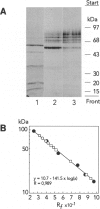Abstract
Proliferation-linked expression of the nuclear Ki-S1 antigen is a significant prognostic indicator in mammary carcinomas. Here, we show staining of a protein of 170 kd by Ki-S1 antibody in immunoblots of Saccharomyces cerevisiae expressing human topoisomerase II alpha but not in the parental strain. In HL-60 cells containing both isoforms of human topoisomerase II, Ki-S1 antibody binds selectively to the 170-kd isoenzyme in a similar fashion as peptide-antibodies directed against amino acid residues 1 to 15 or 1512 to 1530 of human topoisomerase II alpha. Conversely, antibodies directed against carboxyl-terminal sequences of human topoisomerase II beta selectively stain a 180-kd protein. The immunoreactive pattern of V8 endoproteinase restriction digests of human topoisomerase II alpha was identical for Ki-S1-antibody and peptide-antibodies directed against residues 1512 to 1530 but different for peptide-antibodies directed against residues 1 to 15. The Rf values of the smallest fragment commonly recognized by Ki-S1 antibody and the carboxy terminus-specific peptide-antibody place the Ki-S1 epitope within the last 495 carboxyl-terminal amino acid residues of topoisomerase II alpha.
Full text
PDF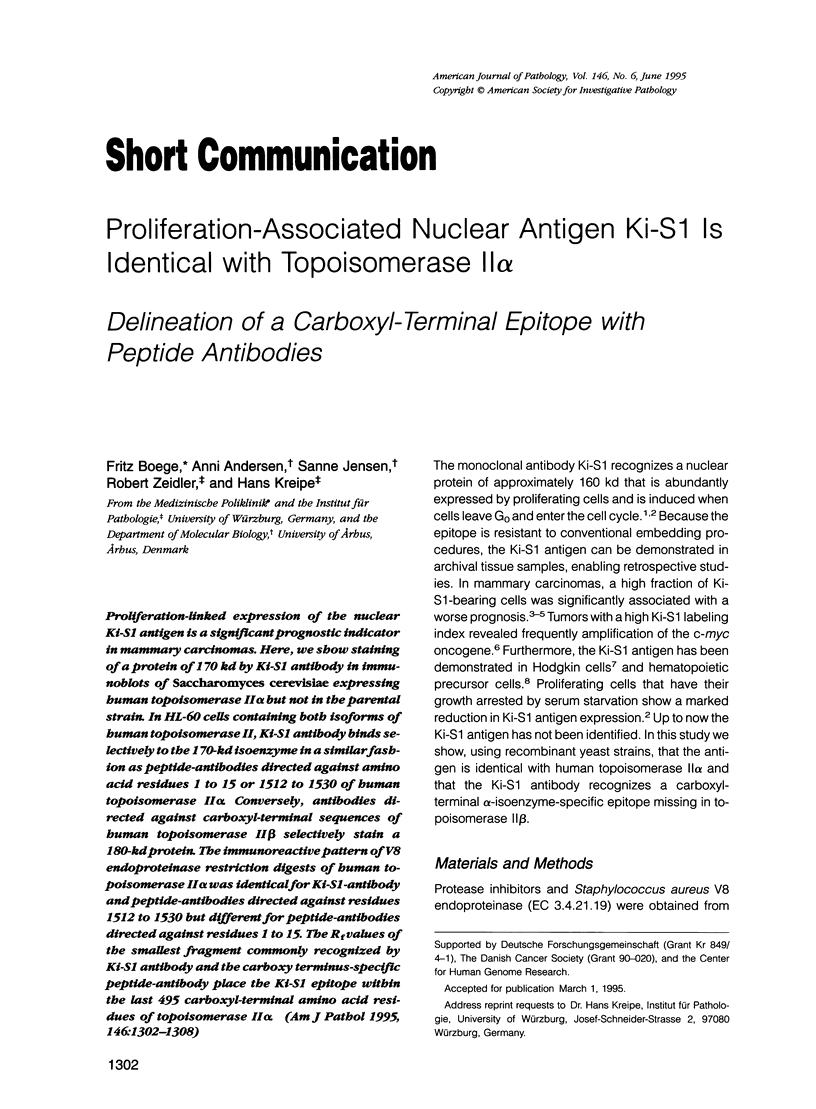
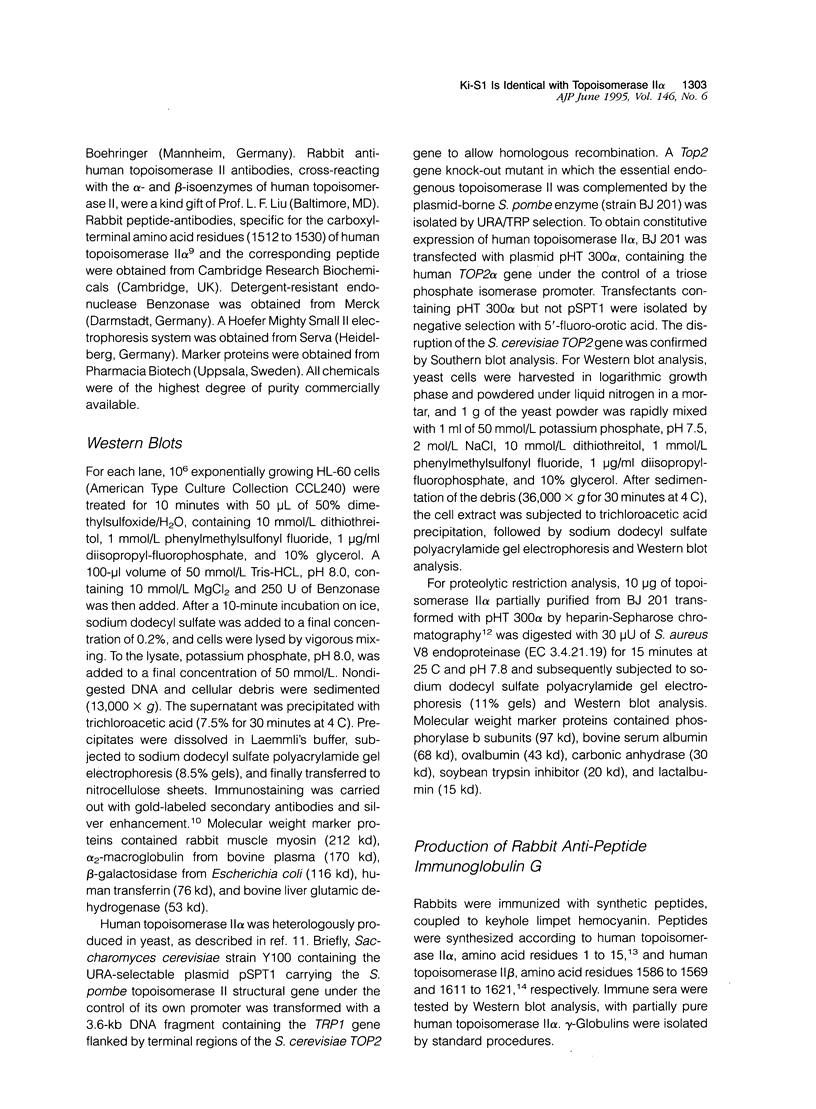
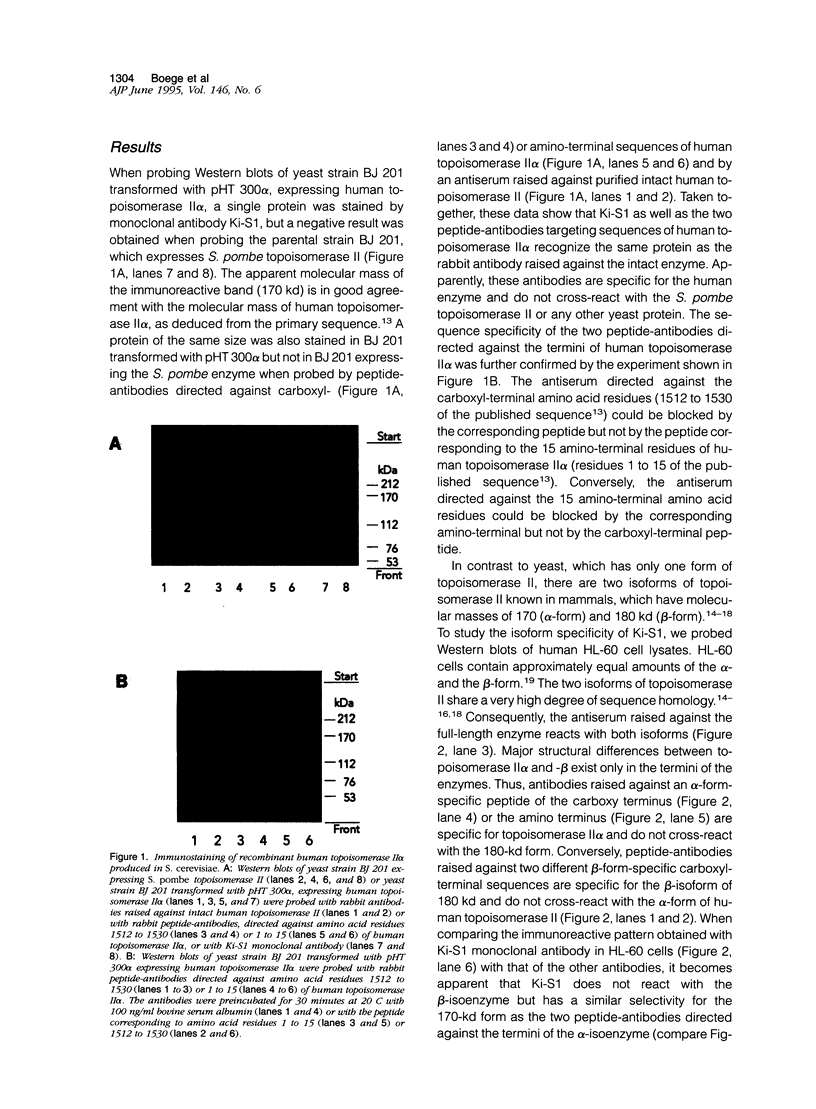
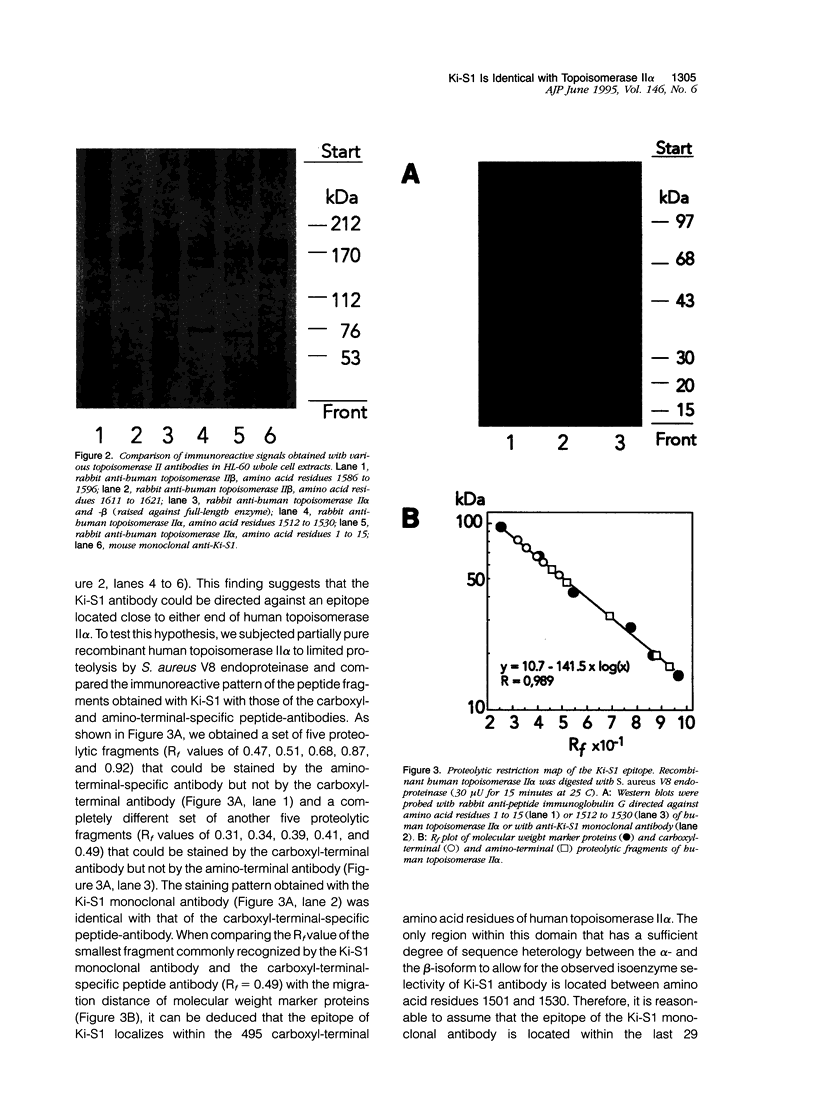
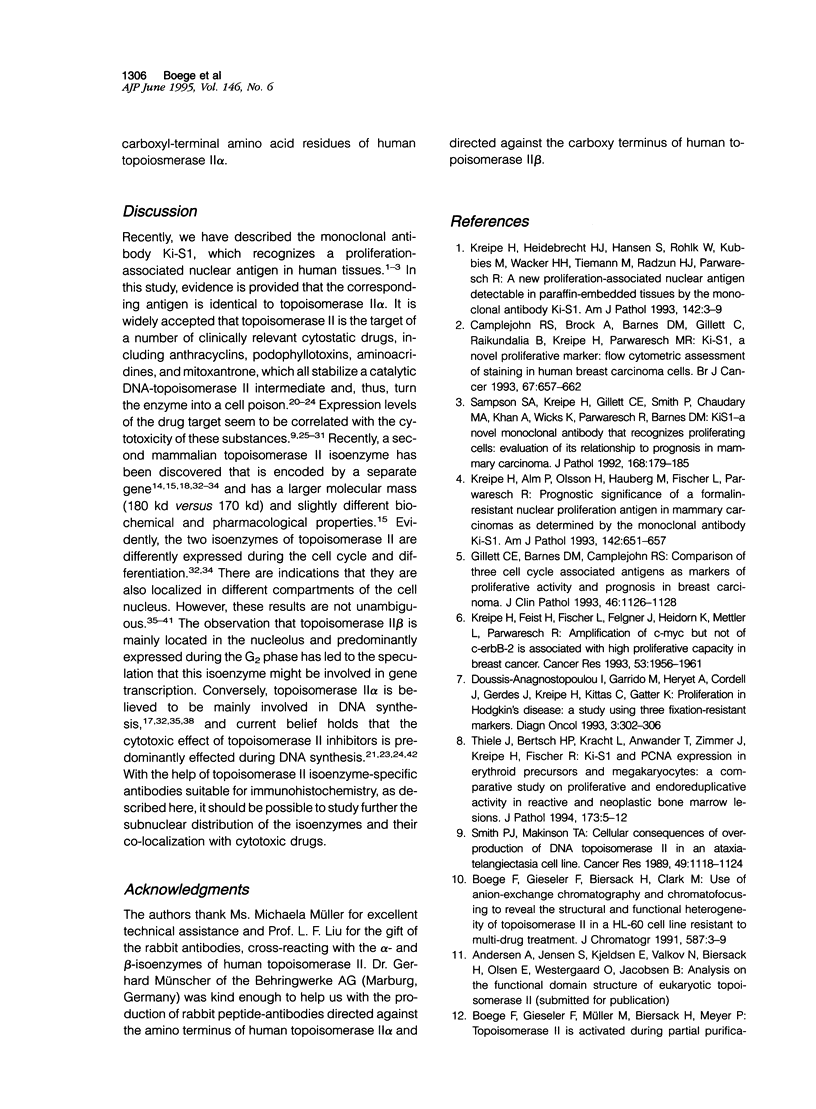
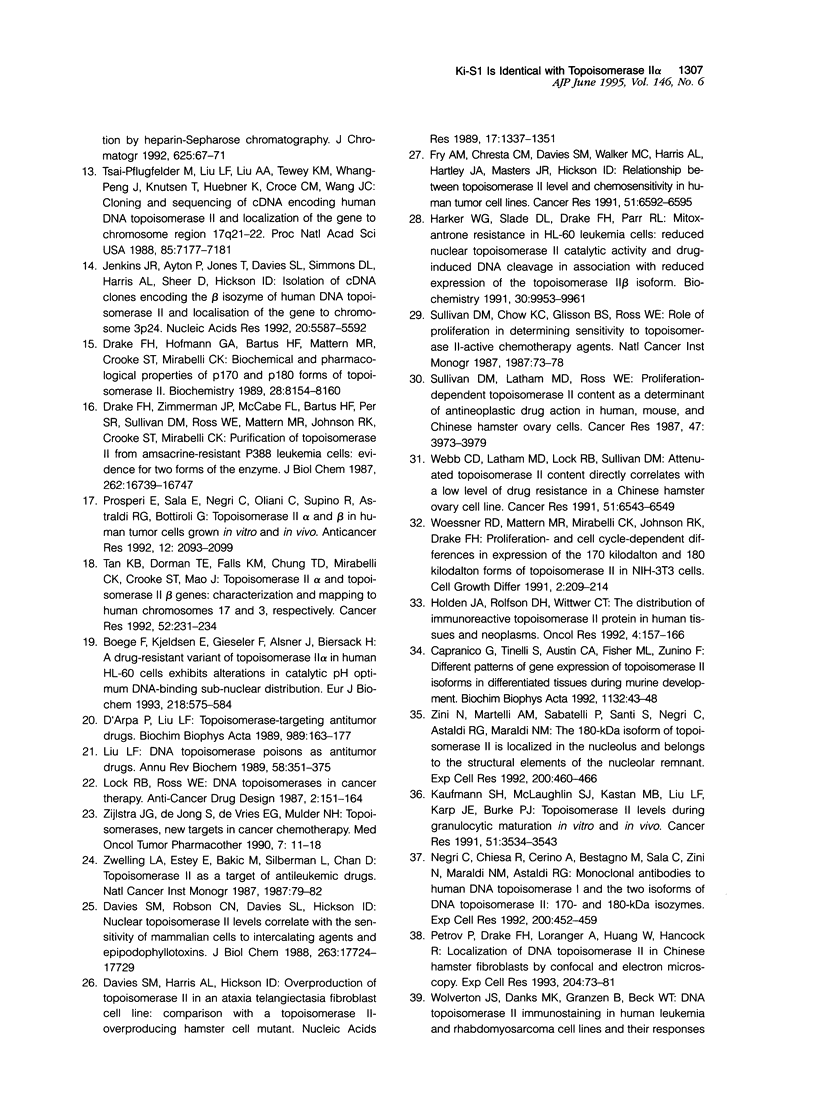

Images in this article
Selected References
These references are in PubMed. This may not be the complete list of references from this article.
- Boege F., Gieseler F., Biersack H., Clark M. Use of anion-exchange chromatography and chromatofocusing to reveal the structural and functional heterogeneity of topoisomerase II in a HL-60 cell line resistant to multi-drug treatment. J Chromatogr. 1991 Nov 29;587(1):3–9. doi: 10.1016/0021-9673(91)85191-h. [DOI] [PubMed] [Google Scholar]
- Boege F., Kjeldsen E., Gieseler F., Alsner J., Biersack H. A drug-resistant variant of topoisomerase II alpha in human HL-60 cells exhibits alterations in catalytic pH optimum, DNA binding and sub-nuclear distribution. Eur J Biochem. 1993 Dec 1;218(2):575–584. doi: 10.1111/j.1432-1033.1993.tb18411.x. [DOI] [PubMed] [Google Scholar]
- Camplejohn R. S., Brock A., Barnes D. M., Gillett C., Raikundalia B., Kreipe H., Parwaresch M. R. Ki-S1, a novel proliferative marker: flow cytometric assessment of staining in human breast carcinoma cells. Br J Cancer. 1993 Apr;67(4):657–662. doi: 10.1038/bjc.1993.122. [DOI] [PMC free article] [PubMed] [Google Scholar]
- Capranico G., Tinelli S., Austin C. A., Fisher M. L., Zunino F. Different patterns of gene expression of topoisomerase II isoforms in differentiated tissues during murine development. Biochim Biophys Acta. 1992 Aug 17;1132(1):43–48. doi: 10.1016/0167-4781(92)90050-a. [DOI] [PubMed] [Google Scholar]
- D'Arpa P., Liu L. F. Topoisomerase-targeting antitumor drugs. Biochim Biophys Acta. 1989 Dec 17;989(2):163–177. doi: 10.1016/0304-419x(89)90041-3. [DOI] [PubMed] [Google Scholar]
- Davies S. M., Harris A. L., Hickson I. D. Overproduction of topoisomerase II in an ataxia telangiectasia fibroblast cell line: comparison with a topoisomerase II-overproducing hamster cell mutant. Nucleic Acids Res. 1989 Feb 25;17(4):1337–1351. doi: 10.1093/nar/17.4.1337. [DOI] [PMC free article] [PubMed] [Google Scholar]
- Davies S. M., Robson C. N., Davies S. L., Hickson I. D. Nuclear topoisomerase II levels correlate with the sensitivity of mammalian cells to intercalating agents and epipodophyllotoxins. J Biol Chem. 1988 Nov 25;263(33):17724–17729. [PubMed] [Google Scholar]
- Drake F. H., Hofmann G. A., Bartus H. F., Mattern M. R., Crooke S. T., Mirabelli C. K. Biochemical and pharmacological properties of p170 and p180 forms of topoisomerase II. Biochemistry. 1989 Oct 3;28(20):8154–8160. doi: 10.1021/bi00446a029. [DOI] [PubMed] [Google Scholar]
- Drake F. H., Zimmerman J. P., McCabe F. L., Bartus H. F., Per S. R., Sullivan D. M., Ross W. E., Mattern M. R., Johnson R. K., Crooke S. T. Purification of topoisomerase II from amsacrine-resistant P388 leukemia cells. Evidence for two forms of the enzyme. J Biol Chem. 1987 Dec 5;262(34):16739–16747. [PubMed] [Google Scholar]
- Fry A. M., Chresta C. M., Davies S. M., Walker M. C., Harris A. L., Hartley J. A., Masters J. R., Hickson I. D. Relationship between topoisomerase II level and chemosensitivity in human tumor cell lines. Cancer Res. 1991 Dec 15;51(24):6592–6595. [PubMed] [Google Scholar]
- Gillett C. E., Barnes D. M., Camplejohn R. S. Comparison of three cell cycle associated antigens as markers of proliferative activity and prognosis in breast carcinoma. J Clin Pathol. 1993 Dec;46(12):1126–1128. doi: 10.1136/jcp.46.12.1126. [DOI] [PMC free article] [PubMed] [Google Scholar]
- Harker W. G., Slade D. L., Drake F. H., Parr R. L. Mitoxantrone resistance in HL-60 leukemia cells: reduced nuclear topoisomerase II catalytic activity and drug-induced DNA cleavage in association with reduced expression of the topoisomerase II beta isoform. Biochemistry. 1991 Oct 15;30(41):9953–9961. doi: 10.1021/bi00105a020. [DOI] [PubMed] [Google Scholar]
- Holden J. A., Rolfson D. H., Wittwer C. T. The distribution of immunoreactive topoisomerase II Protein in human tissues and neoplasms. Oncol Res. 1992;4(4-5):157–166. [PubMed] [Google Scholar]
- Jenkins J. R., Ayton P., Jones T., Davies S. L., Simmons D. L., Harris A. L., Sheer D., Hickson I. D. Isolation of cDNA clones encoding the beta isozyme of human DNA topoisomerase II and localisation of the gene to chromosome 3p24. Nucleic Acids Res. 1992 Nov 11;20(21):5587–5592. doi: 10.1093/nar/20.21.5587. [DOI] [PMC free article] [PubMed] [Google Scholar]
- Kaufmann S. H., McLaughlin S. J., Kastan M. B., Liu L. F., Karp J. E., Burke P. J. Topoisomerase II levels during granulocytic maturation in vitro and in vivo. Cancer Res. 1991 Jul 1;51(13):3534–3543. [PubMed] [Google Scholar]
- Kaufmann S. H., Shaper J. H. Association of topoisomerase II with the hepatoma cell nuclear matrix: the role of intermolecular disulfide bond formation. Exp Cell Res. 1991 Feb;192(2):511–523. doi: 10.1016/0014-4827(91)90071-2. [DOI] [PubMed] [Google Scholar]
- Kreipe H., Alm P., Olsson H., Hauberg M., Fischer L., Parwaresch R. Prognostic significance of a formalin-resistant nuclear proliferation antigen in mammary carcinomas as determined by the monoclonal antibody Ki-S1. Am J Pathol. 1993 Feb;142(2):651–657. [PMC free article] [PubMed] [Google Scholar]
- Kreipe H., Feist H., Fischer L., Felgner J., Heidorn K., Mettler L., Parwaresch R. Amplification of c-myc but not of c-erbB-2 is associated with high proliferative capacity in breast cancer. Cancer Res. 1993 Apr 15;53(8):1956–1961. [PubMed] [Google Scholar]
- Kreipe H., Heidebrecht H. J., Hansen S., Röhlk W., Kubbies M., Wacker H. H., Tiemann M., Radzun H. J., Parwaresch R. A new proliferation-associated nuclear antigen detectable in paraffin-embedded tissues by the monoclonal antibody Ki-S1. Am J Pathol. 1993 Jan;142(1):3–9. [PMC free article] [PubMed] [Google Scholar]
- Liu L. F. DNA topoisomerase poisons as antitumor drugs. Annu Rev Biochem. 1989;58:351–375. doi: 10.1146/annurev.bi.58.070189.002031. [DOI] [PubMed] [Google Scholar]
- Lock R. B., Ross W. E. DNA topoisomerases in cancer therapy. Anticancer Drug Des. 1987 Oct;2(2):151–164. [PubMed] [Google Scholar]
- Negri C., Chiesa R., Cerino A., Bestagno M., Sala C., Zini N., Maraldi N. M., Astaldi Ricotti G. C. Monoclonal antibodies to human DNA topoisomerase I and the two isoforms of DNA topoisomerase II: 170- and 180-kDa isozymes. Exp Cell Res. 1992 Jun;200(2):452–459. doi: 10.1016/0014-4827(92)90195-e. [DOI] [PubMed] [Google Scholar]
- Petrov P., Drake F. H., Loranger A., Huang W., Hancock R. Localization of DNA topoisomerase II in Chinese hamster fibroblasts by confocal and electron microscopy. Exp Cell Res. 1993 Jan;204(1):73–81. doi: 10.1006/excr.1993.1010. [DOI] [PubMed] [Google Scholar]
- Prosperi E., Sala E., Negri C., Oliani C., Supino R., Astraldi Ricotti G. B., Bottiroli G. Topoisomerase II alpha and beta in human tumor cells grown in vitro and in vivo. Anticancer Res. 1992 Nov-Dec;12(6B):2093–2099. [PubMed] [Google Scholar]
- Rose K. M. DNA topoisomerases as targets for chemotherapy. FASEB J. 1988 Jun;2(9):2474–2478. doi: 10.1096/fasebj.2.9.2836254. [DOI] [PubMed] [Google Scholar]
- Sampson S. A., Kreipe H., Gillett C. E., Smith P., Chaudary M. A., Khan A., Wicks K., Parwaresch R., Barnes D. M. KiS1--a novel monoclonal antibody which recognizes proliferating cells: evaluation of its relationship to prognosis in mammary carcinoma. J Pathol. 1992 Oct;168(2):179–185. doi: 10.1002/path.1711680205. [DOI] [PubMed] [Google Scholar]
- Smith P. J., Makinson T. A. Cellular consequences of overproduction of DNA topoisomerase II in an ataxia-telangiectasia cell line. Cancer Res. 1989 Mar 1;49(5):1118–1124. [PubMed] [Google Scholar]
- Sullivan D. M., Chow K. C., Glisson B. S., Ross W. E. Role of proliferation in determining sensitivity to topoisomerase II-active chemotherapy agents. NCI Monogr. 1987;(4):73–78. [PubMed] [Google Scholar]
- Sullivan D. M., Latham M. D., Ross W. E. Proliferation-dependent topoisomerase II content as a determinant of antineoplastic drug action in human, mouse, and Chinese hamster ovary cells. Cancer Res. 1987 Aug 1;47(15):3973–3979. [PubMed] [Google Scholar]
- Swedlow J. R., Sedat J. W., Agard D. A. Multiple chromosomal populations of topoisomerase II detected in vivo by time-lapse, three-dimensional wide-field microscopy. Cell. 1993 Apr 9;73(1):97–108. doi: 10.1016/0092-8674(93)90163-k. [DOI] [PubMed] [Google Scholar]
- Tan K. B., Dorman T. E., Falls K. M., Chung T. D., Mirabelli C. K., Crooke S. T., Mao J. Topoisomerase II alpha and topoisomerase II beta genes: characterization and mapping to human chromosomes 17 and 3, respectively. Cancer Res. 1992 Jan 1;52(1):231–234. [PubMed] [Google Scholar]
- Thiele J., Bertsch H. P., Kracht L. W., Anwander T., Zimmer J. D., Kreipe H., Fischer R. Ki-S1 and PCNA expression in erythroid precursors and megakaryocytes--a comparative study on proliferative and endoreduplicative activity in reactive and neoplastic bone marrow lesions. J Pathol. 1994 May;173(1):5–12. doi: 10.1002/path.1711730103. [DOI] [PubMed] [Google Scholar]
- Tsai-Pflugfelder M., Liu L. F., Liu A. A., Tewey K. M., Whang-Peng J., Knutsen T., Huebner K., Croce C. M., Wang J. C. Cloning and sequencing of cDNA encoding human DNA topoisomerase II and localization of the gene to chromosome region 17q21-22. Proc Natl Acad Sci U S A. 1988 Oct;85(19):7177–7181. doi: 10.1073/pnas.85.19.7177. [DOI] [PMC free article] [PubMed] [Google Scholar]
- Webb C. D., Latham M. D., Lock R. B., Sullivan D. M. Attenuated topoisomerase II content directly correlates with a low level of drug resistance in a Chinese hamster ovary cell line. Cancer Res. 1991 Dec 15;51(24):6543–6549. [PubMed] [Google Scholar]
- Woessner R. D., Mattern M. R., Mirabelli C. K., Johnson R. K., Drake F. H. Proliferation- and cell cycle-dependent differences in expression of the 170 kilodalton and 180 kilodalton forms of topoisomerase II in NIH-3T3 cells. Cell Growth Differ. 1991 Apr;2(4):209–214. [PubMed] [Google Scholar]
- Zijlstra J. G., de Jong S., de Vries E. G., Mulder N. H. Topoisomerases, new targets in cancer chemotherapy. Med Oncol Tumor Pharmacother. 1990;7(1):11–18. doi: 10.1007/BF03000485. [DOI] [PubMed] [Google Scholar]
- Zini N., Martelli A. M., Sabatelli P., Santi S., Negri C., Astaldi Ricotti G. C., Maraldi N. M. The 180-kDa isoform of topoisomerase II is localized in the nucleolus and belongs to the structural elements of the nucleolar remnant. Exp Cell Res. 1992 Jun;200(2):460–466. doi: 10.1016/0014-4827(92)90196-f. [DOI] [PubMed] [Google Scholar]
- Zwelling L. A., Estey E., Bakic M., Silberman L., Chan D. Topoisomerase II as a target of antileukemic drugs. NCI Monogr. 1987;(4):79–82. [PubMed] [Google Scholar]





